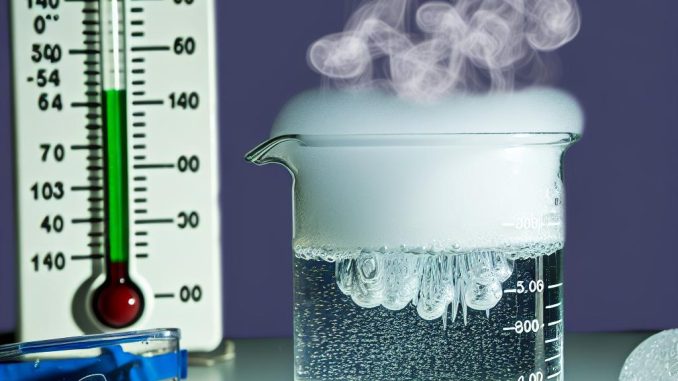
Understanding the Triple Point of Water
To delve into the fascinating phenomenon where water can both boil and freeze simultaneously, it’s essential to understand the concept of the triple point. The triple point is a thermodynamic condition wherein a substance can exist in all three states of matter—solid, liquid, and gas—at the same time. This intriguing scenario occurs at a precise combination of pressure and temperature.
The Specific Conditions
For water, the triple point is reached at a temperature of 0.01°C and a pressure of 611.657 pascals. Under these very specific conditions, ice, liquid water, and water vapor coexist in equilibrium. It’s a unique state that provides profound insights into physical chemistry and advanced thermodynamics.
The Science Behind Boiling and Freezing
At the triple point, the energy input and output balance is such that water molecules have the freedom to transition between phases. When energy is added, some molecules gain enough energy to become gas, hence boiling. Conversely, when energy is lost, some molecules slow down enough to form a solid, thus freezing. Both processes occur without disrupting the phase equilibrium.
Importance in Scientific Measurements
The triple point of water is more than a scientific curiosity; it plays a critical role in precise measurements. The International System of Units (SI) uses the triple point of water to define the kelvin, the base unit of temperature. This connection emphasizes the importance of understanding and accurately measuring the triple point conditions.
Practical Experimentation
Though difficult to replicate without laboratory-grade equipment, observing the triple point of water in an educational setting can be profoundly enlightening. The setup usually involves a vacuum chamber, precise temperature control, and sensitive pressure measuring instruments. Engaging in such experiments helps reinforce theoretical knowledge with tangible observation.
To elaborate further:
The Interplay of Pressure and Temperature
Understanding the interplay of pressure and temperature at the triple point involves recognizing how both factors influence molecular behavior. Pressure can compact molecules, generally fostering a transition to a liquid or solid state. Conversely, decreasing pressure can encourage a liquid to transition to a gas. The 611.657-pascal pressure necessary for water’s triple point precisely balances these forces, facilitating simultaneous phase presence.
The Role of Energy at the Molecular Level
At the molecular level, energy plays a pivotal role in phase transitions. Molecules in a substance constantly exchange energy; those on the surface of a liquid might gain enough energy to escape as gas, while some gas molecules may lose energy and condense into a liquid. In the triple-point scenario, this energy exchange reaches equilibrium, where no net energy transfer between phases occurs, stabilizing the coexistence of all phases.
Historical Discovery and Implications
The concept of a triple point dates back to the early days of thermodynamics when scientists began mapping phase diagrams of various substances. Its discovery was significant for refining our understanding of the phase behavior of materials. The implications of this understanding extend beyond theoretical physics and chemistry, having practical applications in meteorology, engineering, and environmental science.
Applications in Various Fields
In meteorology, the principles underlying the triple point help in understanding cloud formation and the water cycle. Atmospheric pressure and temperature variations often lead to similar phase changes in weather systems. Engineering disciplines utilize these principles in the development of cooling systems and pressure-based chemical processes. Recognizing how substances behave at their triple points is crucial for designing equipment that performs efficiently under varying thermal conditions.
Educational Importance
In education, laboratories sometimes simulate the triple point scenario to visually and analytically demonstrate phase changes and equilibrium. Understanding this concept is vital for students in thermodynamics and related courses, offering a practical illustration of theoretical principles. Such experiments enrich educational experiences by linking classroom theory with real-world phenomena.
Challenges in Measurement and Replication
Measuring and replicating the triple point of water, though conceptually straightforward, poses several practical challenges. Conditions need to be controlled with extreme precision, often requiring sophisticated apparatus capable of maintaining constant temperature and pressure. Error margins in such experiments can lead to inaccurate representation, underscoring the need for meticulous attention to experimental design.
Modern Advances and Future Research
Modern advances in technology have enhanced our capabilities to study the triple point of various substances, not just water. Future research may explore this phenomenon under varying conditions, potentially uncovering new applications in fields like nanotechnology or material science. Exploring triple points in other compounds could reveal insights applicable to developing new materials and enhancing industrial processes.
Conclusion and Further Exploration
The triple point of water remains a cornerstone in the study of thermodynamics, illustrating the delicate balance of natural forces. This concept not only enhances our comprehension of water’s properties but also serves as a benchmark for scientific precision in measurement. For those interested in further exploration, numerous research articles and educational resources delve into these complexities, fostering a deeper appreciation for this fascinating thermodynamic phenomenon. Engaging with these materials can provide a comprehensive understanding of the triple point and its broader implications in scientific research and application.
